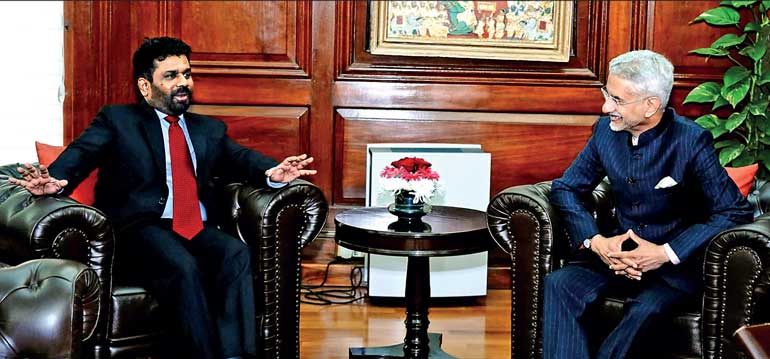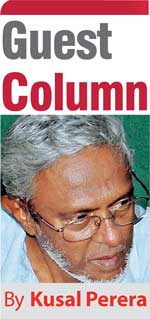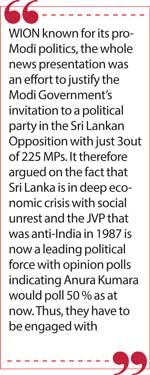Monday Jan 12, 2026
Monday Jan 12, 2026
Friday, 9 February 2024 00:20 - - {{hitsCtrl.values.hits}}

New Delhi and JVP now show their willingness to accommodate each other for political advantage
 A week and a month already gone by this new year, marking the closing of Independence Day celebrations on 4 February was the JVP leader MP Anura Kumara Dissanayake with MP Vijitha Herath leaving with two others to New Delhi, officially invited for mutual discussions by the External Affairs Minister Dr. Jaishankar. This incidentally is not the first official invitation to the JVP leadership from New Delhi. The first on behalf of the New Delhi Government was extended by the Indian High Commissioner in Colombo for their Independence Day celebrations on 15 August 2002 at India House, Colombo. New Delhi was then opposed to the Norwegian facilitated peace negotiations between GOSL and the LTTE. The peace negotiations were opposed by the JVP and the Sinhala extremists; with President Kumaratunge and Minister Mangala Samaraweera backing them. Invitations to the JVP for India’s Independence Day celebrations thus inferred the JVP was being outsourced for the job.
A week and a month already gone by this new year, marking the closing of Independence Day celebrations on 4 February was the JVP leader MP Anura Kumara Dissanayake with MP Vijitha Herath leaving with two others to New Delhi, officially invited for mutual discussions by the External Affairs Minister Dr. Jaishankar. This incidentally is not the first official invitation to the JVP leadership from New Delhi. The first on behalf of the New Delhi Government was extended by the Indian High Commissioner in Colombo for their Independence Day celebrations on 15 August 2002 at India House, Colombo. New Delhi was then opposed to the Norwegian facilitated peace negotiations between GOSL and the LTTE. The peace negotiations were opposed by the JVP and the Sinhala extremists; with President Kumaratunge and Minister Mangala Samaraweera backing them. Invitations to the JVP for India’s Independence Day celebrations thus inferred the JVP was being outsourced for the job.
Meanwhile, New Delhi and the JVP now show their willingness to accommodate each other for political advantage, despite the JVP’s inherently anti-Indian local politics. Sometime back in Parliament, Anura Kumara with a long list of Indian interests in Sri Lanka accused the Government of selling Sri Lanka to Indian vested interests. He began the list with repairs at the Duraiappah Stadium, KKS harbour expansion, Palali airport modernising, four acres of the Nilaveli beach given to Indian hoteliers, Pulmudai Mineral Sands Corporation to be sold to Birla but reversed by trade union protests, and also claimed that India invaded the power and energy sector and carved out the fuel market.
NPP presents
more moderate
pro-business image
With their new campaign for elections leaving aside issue-based agitations and protests, the JVP with their NPP front, led by Anura Kumara Dissanayake a very vocal campaigner in Sinhala is in the process of creating for themselves a more moderate pro-business image expecting to overtake Sajith Premadasa and his SJB to gain political power. Urbanised, clad in western attire and presenting a new look with an anti-corruption façade has made the JVP an acceptable alternative for the urban middle class at the expense of their traditional poverty driven rural lower middle class. In Sri Lankan electoral politics the urban middle class is accepted in the media as the social opinion maker.
Voter opinion polls
 Caught in this urban trend, Colombo centric entities calculating on voter opinion polls have also come up with percentages giving heavy leverage to the JVP/NPP. With samples used and their demographic and geographic representations not quite clear, the Institute for Health Policy (IHP) also announced their “general election voting intention poll among Sri Lankan adults in December 2023” indicating 39% for the NPP, leaving the SJB with 27 %, and the rest of the lot all given 10 % and less.
Caught in this urban trend, Colombo centric entities calculating on voter opinion polls have also come up with percentages giving heavy leverage to the JVP/NPP. With samples used and their demographic and geographic representations not quite clear, the Institute for Health Policy (IHP) also announced their “general election voting intention poll among Sri Lankan adults in December 2023” indicating 39% for the NPP, leaving the SJB with 27 %, and the rest of the lot all given 10 % and less.
The expertise and mandate the IHP has in getting into politics is very much in question. The IHP “is an independent research institution and a regional centre of excellence for health policy research” according to their web. Instead of focusing on issues like the impact of private practice by medical doctors and technical staff on the National Health Service or developing a more secure and safe procurement system for medicinal drugs and equipment, they have dabbled with a subject wholly alien to them. Calculating voting patterns differ very much from calculating malnutrition in children under five years.
Voting
patterns differ
Voting patterns differ from district to district, depending on numerous issues from caste, ethnicity and religion to personality cults and how much money is spent on campaigns. Were they taken into the calculations? Can the JVP as the JJB in 2020 that polled only 1.2 % in Nuwara Eliya now poll more than the 31.2 % that the SJB polled in 2020? How much would the JVP that in 2020 polled 4.1 % in Moneragala, now poll with a wholly urban new business outlook? With only 3.7 % in 2020 in Kurunegala, can they now come anywhere close to the 67 % polled by the SLPP?
If 80 % of the total registered voter population go to polls, all main presidential candidates that are basically Southern Sinhala must collect 6.6 million from the 19 electoral districts excluding Jaffna, Vanni and Batticaloa to clear the hurdle of 50 % plus. The one crore Indian Rupee question is, can the JVP that polled 0.42 million (3.16%) in all 22 electoral districts leap as high as 6.6 million votes from the Sinhala South in just four years? What is the attraction for 6.2 million more voters to go for Anura Kumara when he is now no different from other conventional politicians, except for his rhetoric?
AKD tipped to poll
50 % of votes – WION
Sadly, a popular Indian TV channel WION giving their own interpretation of the NPP visit to New Delhi, called them “a Marxist-Leninist party in Sri Lanka” (ha ha!) they never were. WION quoted IHP figures without first checking on their credibility to be in opinion poll surveys of elections, to say that Anura Kumara as a presidential candidate is tipped to poll 50 % that is 6.6 million votes as against the 0.42 million polled four years ago. WION known for its pro-Modi politics, the whole news presentation was an effort to justify the Modi Government’s invitation to a political party in the Sri Lankan Opposition with just 3out of 225 MPs. It therefore argued on the fact that Sri Lanka is in deep economic crisis with social unrest and the JVP that was anti-India in 1987 is now a leading political force with opinion polls indicating Anura Kumara would poll 50 % as at now. Thus, they have to be engaged with.
What for? To ensure they would not take “anti-Indian” positions in the future. Why should the Modi Government take such trouble in neutralising “anti-Indian sentiments” in Sri Lanka, the South bloc was never worried about in the past? Not even when Indira Gandhi as PM decided and went ahead with her political project to fund and train armed Sri Lankan Tamil youth in the early 80s including the LTTE to destabilise the Jayewardene regime? There were two major political factors then that allowed New Delhi to manage South Asia as they felt. One, China was not a fast-growing dragon that would step on South Asia with its increasingly heavy economic power. Two, New Delhi took for granted that its “big brother” image could leverage politics in SAARC as they did and subsequently initiated the BRICS.
China a formidable force to reckon with
 The new millennium changed all that and left a new political equation that made China a formidable force in South Asia challenging Indian authority in the Bay of Bengal, the Arabian Sea and the Indian Ocean south of India. With absolutely no say on pro-China Pakistani politics, India needed the Maldives and Sri Lanka to come under its political influence to continue Indian authority in the Indian Ocean sea routes the Chinese began using extensively. China needed large fuel shipments in the new millennium for their fast-growing industries and new mega city urban life. “Every day, nearly 60 fully loaded very large crude-oil carriers sail between the Persian Gulf and Chinese ports through the Indian Ocean, carrying about half of the oil” (MarineLink – 13 December 2023) so that the Chinese economy needs and cannot do without. Therefore, within the Belt and Road Sea route, China has gained control of the Gwadar seaport in Pakistan, the Hambantota port and the newly created Colombo Port City in Sri Lanka and the Malaysian Huangjing seaport in the Malacca Straits to be completed in 2025 with Chinese funds totalling $ 80 billion.
The new millennium changed all that and left a new political equation that made China a formidable force in South Asia challenging Indian authority in the Bay of Bengal, the Arabian Sea and the Indian Ocean south of India. With absolutely no say on pro-China Pakistani politics, India needed the Maldives and Sri Lanka to come under its political influence to continue Indian authority in the Indian Ocean sea routes the Chinese began using extensively. China needed large fuel shipments in the new millennium for their fast-growing industries and new mega city urban life. “Every day, nearly 60 fully loaded very large crude-oil carriers sail between the Persian Gulf and Chinese ports through the Indian Ocean, carrying about half of the oil” (MarineLink – 13 December 2023) so that the Chinese economy needs and cannot do without. Therefore, within the Belt and Road Sea route, China has gained control of the Gwadar seaport in Pakistan, the Hambantota port and the newly created Colombo Port City in Sri Lanka and the Malaysian Huangjing seaport in the Malacca Straits to be completed in 2025 with Chinese funds totalling $ 80 billion.
Political hold on
Sri Lanka now vital to India
With such Chinese control of the sea routes from the Persian Gulf through the Arabian Sea and the Indian Ocean north of the Maldives and south of Sri Lanka to Malacca, India believes its political hold on Sri Lanka is now far more vital than it was before the Maldivian presidential elections in 2023. Opposition candidate Mohamed Muizzu winning elections, shifted Maldivian allegiance to China. He wants the major group of Indian troops stationed in the Maldivian archipelago to be withdrawn by March and the rest before 10 May. India’s threat that it would boycott the Maldives as a popular tourist destination for Indians, also has not deterred President Muizzu to step back. Making a statement that being a small nation does not mean the Maldives could be “bullied” he has turned towards Chinese tourists as a diversification.
India has basically lost the battle for now, thus their new turn towards neutralising anti-Indian politics in Sri Lanka. They cannot afford to lose the Maldives and allow anti-Indian politics to dominate Sri Lanka as well. Hence, their invitation to the JVP that is also scouting around for international patronage to tell the Sri Lankan middle class that a JVP Government will not isolate Sri Lanka in global politics.
The compromise has allowed the JVP to continue with their Sinhala-Buddhist politics with India making certain the latter would not discuss North-East issues, 13A and devolution of powers. Discussions as both parties indicate have been on economics, national security and geo-political concerns.
Where to from here?
This election year with presidential elections to come in about eight or nine months, leads to a political triangle of RW and SLPP on a compromise, SJB and breakaway elements from the SLPP collecting around Sajith Premadasa and JVP/NPP projecting a social alliance with the urban middle class. All three in a single triangle with whatever rhetorical differences, have only one political agenda. One that accepts the IMF program and free market economy. Elections would thus lead to a hung Parliament, leaving much uncertainty as to where, from here.